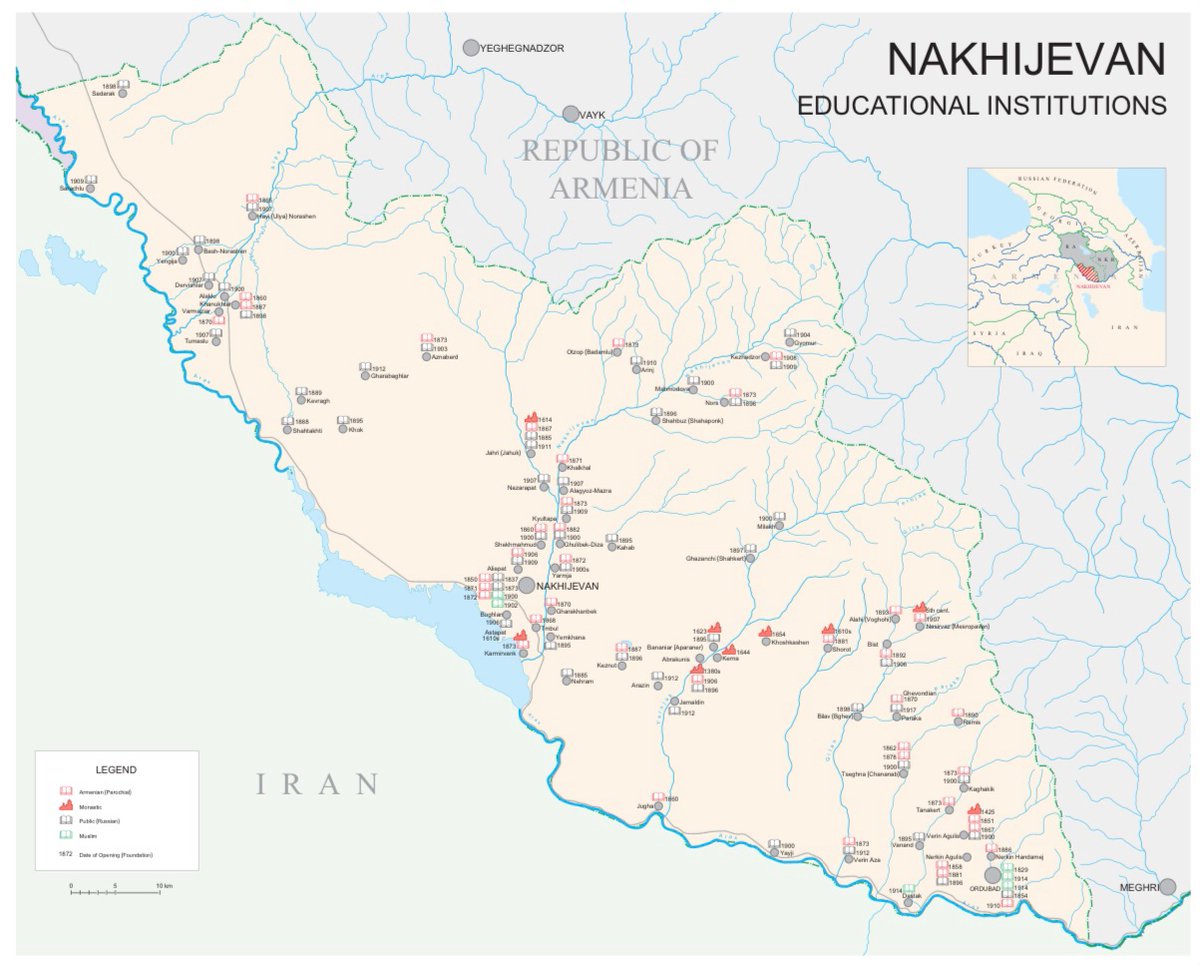
2) The the name "Nakhichevan" in #Armenian literally means "the place of first descent", a Biblical reference to the descent of Noah's Ark on the adjacent Mount #Ararat. Armenian tradition says that Nakhichevan was founded by Noah. 

3) The region was at the center of the ancient Kingdom of #Armenia (858 BC-428 CE). During the invasion by Sassanid #Persian Shah Shapur II (r. 309-379) he removed 2,000 Armenian and 16,000 #Jewish families from #Nakhichevan (360-370 CE). 



4) In 405 CE, Saint Mesrop Mashtots created the Alphabet alphabet in the Goghtn district of classical #Armenia’s Vaspurakan Province (corresponding to modern-day Ordubad, #Nakhichevan). In 428 it fell to the Sassanid #Persian Empire, becoming part of the Province/Marz of Armenia. 



5) In 640-645 CE the #Muslim #Arabs invaded #Armenia, establishing the Emirate of Armenia, their strongholds were in Dvin and #Nakhichevan. In 705 CE, some 800 #Armenian nobles were locked in churches and burned alive in Nakhichevan by Umayyad Emir Muhammad ibn Marwan. 



6) In 885 CE, the Bagratuni family threw off #Muslim #Arab rule they reestablished the Kingdom of #Armenia. #Nakhichevan changed hands constantly between Armenia and local Muslim emirs subordinate to the #Abbasid #Caliphate centered in #Baghdad. 

7) The #Armenian Bagratunis held #Nakhichevan in 885-895; 895-909; and 929-942. The Sajid Emirs held it in 895 and 909-929. The Sallarid Emirs held it in 942-971. While the Shaddadid Emirs held it from 971-1055. In 1055, the Seljuk #Turks conquered #Nakhichevan. 

8) In 1136, #Nakhichevan was given to the Eldiguzid Atabegs of Kipchak origin. In 1197, the #Armenian Zakarian generals led the #Georgian armies south and liberated Nakhichevan, making it part of their principality (map). In 1225 the city was taken back by the Eldiguzid Atabegs. 



9) In 1236, the #Mongols took #Nakhichevan. In the 13-15th centuries the city passed from the Mongol Ilkhanate, later Chobanid Mongols to the #Turkmen Kara Koyunlu and Ak Koyunlu tribal confederations and even fell to the Turko-Mongol warlord #Tamerlane. 



10) In 1501, the #Safavid Empire of #Iran conquered the area, it wouldn’t be long before the #Ottoman Empire of #Turkey would push east and clash with the Iranians. During the Ottoman–Safavid War (1603–1618) the Safavid Shah Abbas (r. 1588-1629) made an irreversible decision. 

11) In 1604, Shah Abbas of #Iran ordered the expulsion of the populations of #Nakhichevan, modern-#Armenia’s Shirak, Lori, Aragatsotn, Kotayk, Gegharkunik, Armavir, #Yerevan, #Ararat and Vayots Dzor Provinces along with modern-day #Turkey’s provinces of #Kars, Agri, and Igdir. 

12) Between 300,000-500,000 #Armenians were forcibly removed and less than half made it to central Iran. New Julfa being the main settlement. In return, Shah Abbas II (r. 1642-1666) of #Safavid #Iran permitted the loyal #Shia #Turkic Kangerli tribe to resettle #Nakhichevan. 



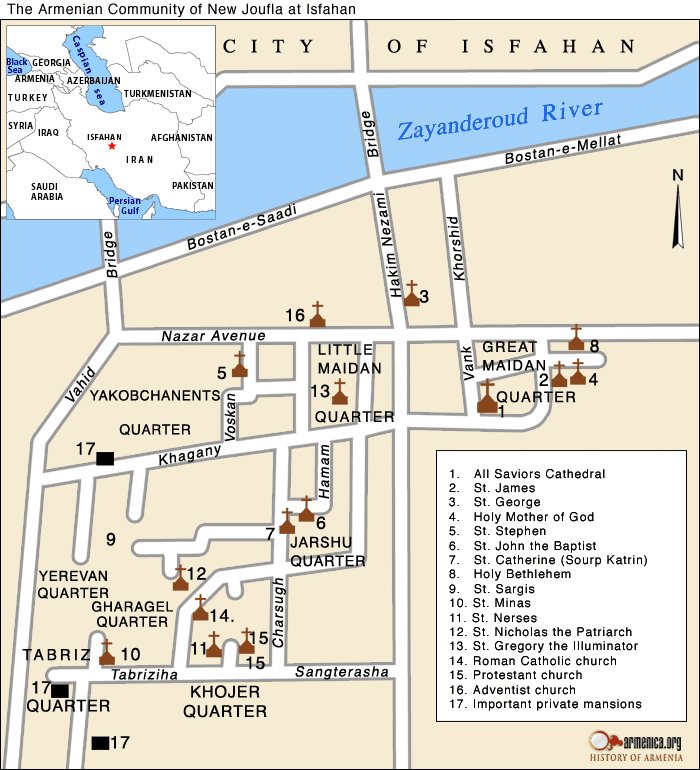



13) #Nakhichevan was ruled by #Shia #Turkic tribesmen loyal to the #Iranian Shah until 1828, initially the #Yerevan Velayet (1501-1736) and later as the Nakhichevan Khanate (1747-1828). Following the Treaty of Turkmenchay it became part of the Russian Empire's Armenian Oblast. 







14) The #Russian authorities invited #Armenians from #Ottoman #Turkey and #Qajar #Iran to resettle in these derelict lands, 140,000 did. The Armenians of Nakhichevan numbering 5,078 (404 families) were joined by 12,019 foreign Armenians (1,128 families), almost all from Iran. 

15) From 1828-1840 #Nakhichevan was part of the #Armenian Oblast and later part of the #Yerevan Governorate (1840-1917). In 1917 the region was home 135,000 people: 81,100 #Muslims (60%) and 53,900 #Armenians (40%). 

16) The first act of violence occurred when Azerbaijanis attacked Nakhichevan’s Armenians on May 25, 1905. 47 of the 52 Armenian villages were attacked, 19 of which were completely destroyed. 239 Armenians died. Later Armenians attacked a Muslim village killing 36 Azerbaijanis. 







17) May 1918 #Armenia, #Azerbaijan and #Georgia became independent and war broke out. In June 1918 the #Ottoman #Turks invaded #Nakhichevan, massacring 10,000 Armenians and destroying 45 of their villages. In October 1918 the Ottomans retreated and Armenia was left in control. 

18) In December 1918, local #Muslims declared the Aras Republic in #Nakhichevan. In June 1919 #Armenian troops took Nakhichevan back and crushed the Republic. In response the #Ottomans #Turks invaded once again with Azerbaijanis and massacred up to 12,000 Armenians in July 1919. 
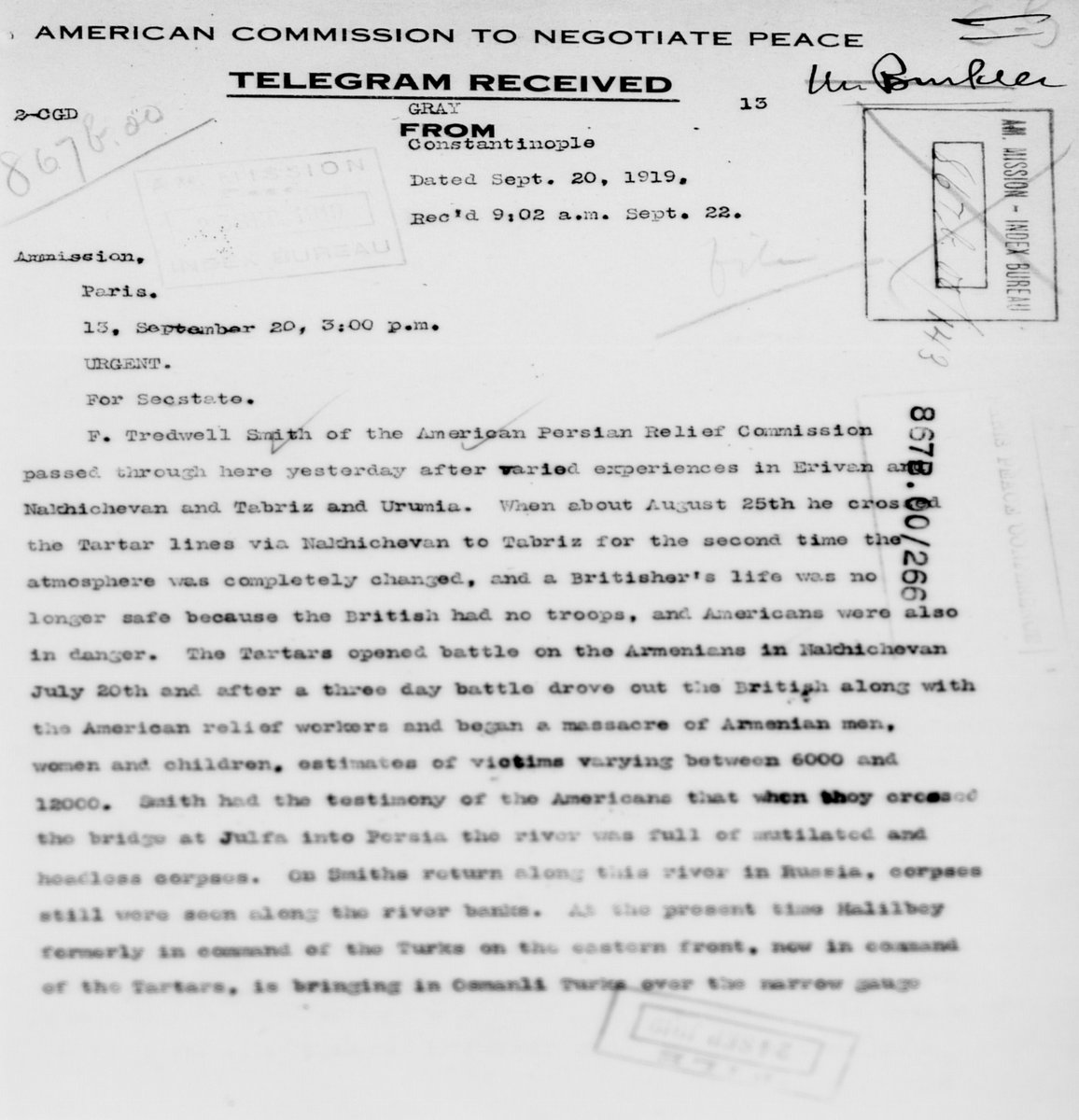
19) The region remained unstable as #Armenians tried to stabilize their rule in response to constant uprisings by local #Muslims militarily backed by #Azerbaijan and #Turkey. In March 1920 #Armenia launched an operation and solidified its control over #Nakhichevan. 
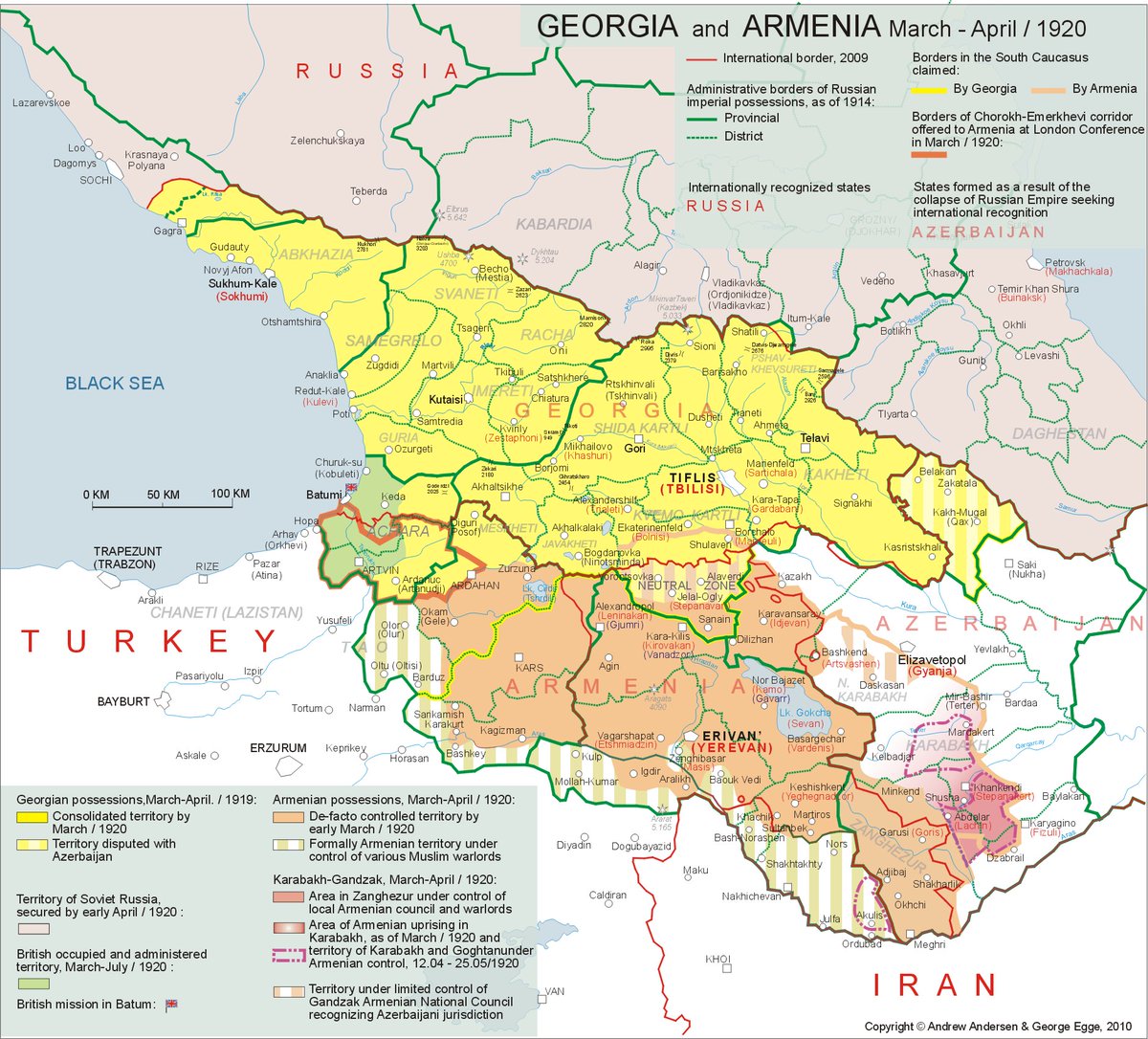
20) In July 1920, the #Soviets took over #Nakhichevan. In November 1920 on the eve of the Soviet invasion of #Armenia, Soviet #Azerbaijani authorities recognized #Nakhichevan, #Syunik (#Zangezur), and #Artsakh (#Karabakh) as part of Soviet #Armenia. 

21) However, #Nakhichevan had become largely emptied of #Armenians and in January 1921 a referendum found 90% of locals who were now largely ethnic #Azerbaijanis wanted to have autonomous status within #Soviet #Azerbaijan. 

22) In March 16, 1921 the #Nakhichevan Autonomous #Soviet Socialist Republic was created and put under the protection of Soviet #Azerbaijan. It was formally integrated into Soviet Azerbaijan on February 9, 1924. 

23) The 1926 #Soviet census found 104,656 people in #Nakhichevan: 88,433 #Azerbaijanis (84.3%) and 11,276 #Armenians (10.8%). By 1989 there 293,875 people in Nakhichevan: 281,807 Azerbaijanis (95.9%) and 1,858 Armenians (0.6%). 

24) Over the years of #Soviet rule (1920-1991) the #Armenian population kept on decreasing. The ~2,000 remaining Armenians were expelled during the Nagorno #Karabakh War (1988-1994) by #Azerbaijan. Today Nakhichevan is home to 398,323 people: 396,709 Azerbaijanis (99.6%). 

25) #Azerbaijan not only ethnically cleansed the local #Armenians but also erased any trace of their ancient presence, including the destruction of all churches and most notoriously the destruction of the Cemetery at Jugha (Julfa) and its 10,000 medieval khachkars in 2005. 

26) Church of Otzop village, Chahuk District of Syunik Province built in 1611. Its currently located in the Badamlı village, Şahbuz Rayon of Nakhichevan. 







27) Saint Jacob of Nisibis Monastery of Paraka village, Goghtn District of Vaspurakan Province, built in the 12th century; rebuilt 1691-1701. Its currently located in the Parağa village, Ordubad Rayon of Nakhichevan. 





28) Saint John Church of Chahuk village, Chahuk District of Syunik Province, built in the 12th century; rebuilt in 1640. Its currently located in the Cəhri village, Babək Rayon of Nakhichevan. 







29) Holy Mother of God Church of Ramis village, Goghtn District of Vaspurakan Province, built in the 12th century; rebuilt in 1677-1678. Its currently an abandoned village north of the Məzrə village, Ordubad Rayon of Nakhichevan. 







30) Holy Mother of God Church of Aliabad village, Nakhichevan District of Vaspurakan Province, built in the 17th century; rebuilt in 1887. Its currently located in the Əliabad district of Naxçıvan City of Nakhichevan. 



31) Holy Mother of God Church of Tsghna village, Goghtn District of Vaspurakan Province, built in the 12th century; rebuilt in the 17th century. Its currently located in the Çənnəb village, Ordubad Rayon, Nakhichevan. 




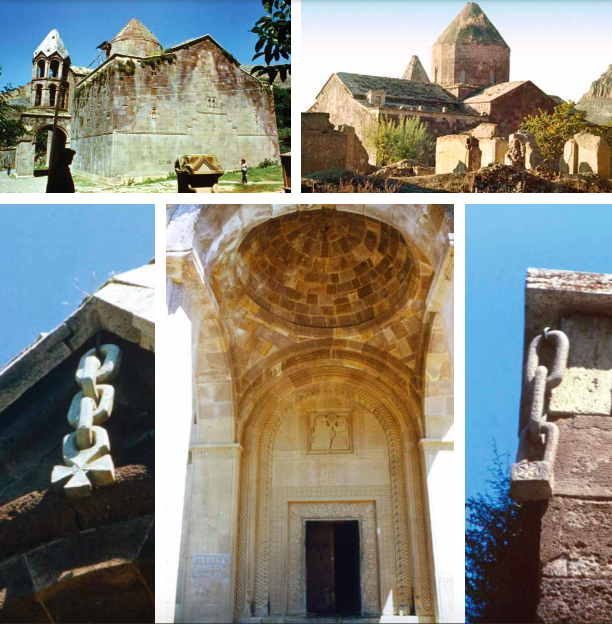


32) Saint George Church, Nakhichevan City of Vaspurakan Province, built in 1869-1872. Its currently located in the Naxçıvan City of Nakhichevan. 



33) Saint John the Baptist Monastery of Abrakunis village, Goghtn District of Vaspurakan Province; built in 1381; rebuilt in 1648-1649. Its currently located in the Əbrəqunus village, Culfa Rayon of Nakhichevan. 







34) In 2013, a mosque was opened on the site of the former Saint John the Baptist Monastery by the Azerbaijani government in the village. 



35) Saint John Monastery, Shorot village, Goghtn District of Vaspurakan Province, rebuilt in 1642. Its currently located in the Şurud village, Culfa Rayon of Nakhichevan. 





36) Verin/Upper Agulis and Nerkin/Lower Agulis were first mentioned in the 11th century. Home to 10,000 Armenians in the 18th century, by 1914 it was home to only 3,500 Armenians. On December 24-25, 1919 the Ottoman Turks massacred 1,400 Armenians here. 







37) A sketch by the prominent Azerbaijani satirist Mirza Jalil comparing Nakhichevan’s large cities, the Armenian Christian-populated Agulis (left) with the Turkic Muslim-populated Ordubad (right) in 1909. Today Agulis’s Armenians are gone and its home to 3,000 Azerbaijanis. 
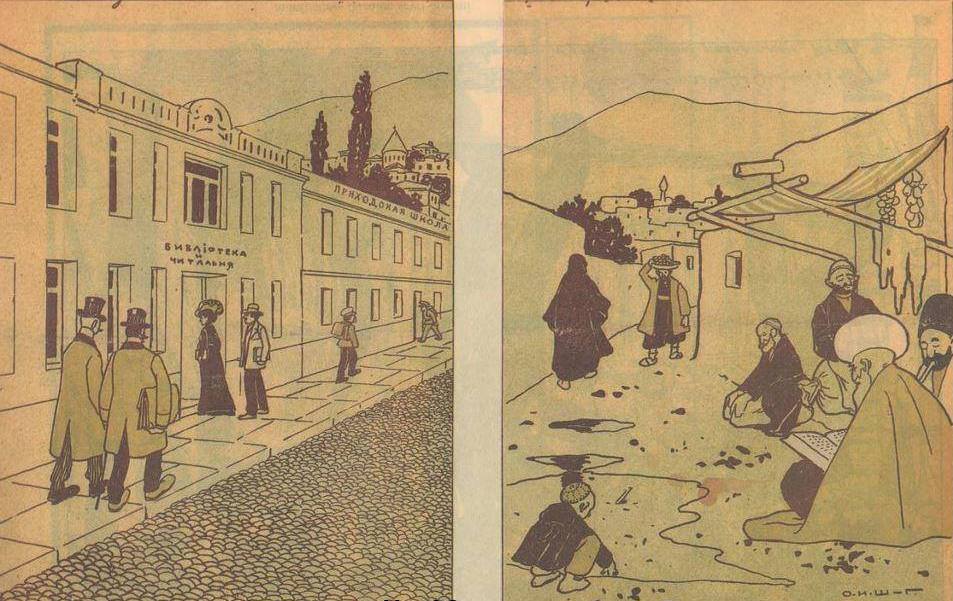
38) Holy Sign and Saint Stephen Churches of Nerkin Agulis, Goghtn District of Vaspurakan Province. Its currently located in the Aşağı Əylis village, Ordubad Rayon of Nakhichevan. 

39) Saint John Church of Verin Agulis, Goghtn District of Vaspurakan Province, rebuilt in the 17th century. Its currently located in the Yuxarı Əylis village, Ordubad Rayon of Nakhichevan. 

40) Saint Jacob of Nisibis Church of Verin Agulis, Goghtn District of Vaspurakan Province, rebuilt in the 17th century of Verin Agulis. Its currently located in the Yuxarı Əylis village, Ordubad Rayon of Nakhichevan. 

41) Saint Simon Church of Verin Agulis, Goghtn District of Vaspurakan Province, rebuilt in the 17th century. Its currently located in the Yuxarı Əylis village, Ordubad Rayon of Nakhichevan. 



42) Holy Mother of God Church of Verin Agulis, Goghtn District of Vaspurakan Province, rebuilt in the 17th century of Verin Agulis. Its currently located in the Yuxarı Əylis village, Ordubad Rayon of Nakhichevan. 

43) Saint Christopher Church of Verin Agulis, Goghtn District of Vaspurakan Province, rebuilt in 1671-1675. Its currently located in the Yuxarı Əylis village, Ordubad Rayon of Nakhichevan. 

44) Saint Thomas the Apostle Monastery of Verin Agulis, Goghtn District of Vaspurakan Province, rebuilt in the 17th century of Verin Agulis. Its currently located in the Yuxarı Əylis village, Ordubad Rayon of Nakhichevan. 







45) In 2014, a mosque was opened on the site of the former Saint John the Baptist Monastery by the Azerbaijani government in the village. 



46) Saint Stephen Church of Verin Agulis, Goghtn District of Vaspurakan Province, rebuilt in the 17th century. Its currently located in the Yuxarı Əylis village, Ordubad Rayon of Nakhichevan. 

47) Saint George Church of Jugha, Goghtn District of Vaspurakan Province, built in 1851. Its currently located in the Gülüstan village, Culfa Rayon of Nakhichevan. Jugha was home to 763 people in 1897, of which 751 were Armenians. 

48) New Cemetery of Jugha, Goghtn District of Vaspurakan Province, with 3,000 graves. Its currently located in the Gülüstan village, Culfa Rayon of Nakhichevan. 

49) Holy Savior Monastery of Old Jugha, Goghtn District of Vaspurakan Province, built in the 9th century. Its currently located 2 km west of the Gülüstan village, Culfa Rayon of Nakhichevan. 





50) Pombloz Chapel of Old Jugha, Goghtn District of Vaspurakan Province, built in the 12th century; rebuilt in the 16th century. Its currently located 2 km west of the Gülüstan village, Culfa Rayon of Nakhichevan. 



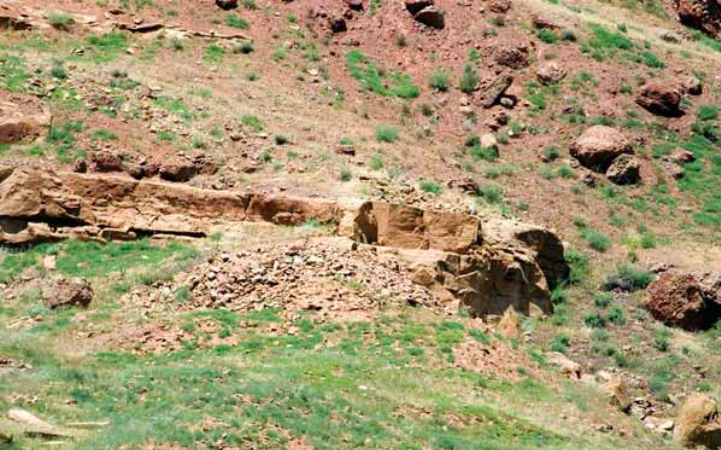

51) The cemetery of Old Jugha, Goghtn District of Vaspurakan Province. Dating back to the 1st century BC, it grew to a town in 9-14th century, becoming a city of 20,000 with 9 churches in the 15-17th century. The city was emptied in 1604 by Iranian authorities. 







52) In 1648, an estimated 10,000 khachkars were counted over 3 hills. There were 5,000 standing in 1904, but many were destroyed in 1908 during the construction of the railway from Yerevan to Jugha. There were 2,700 khachkars still standing in 1983. 





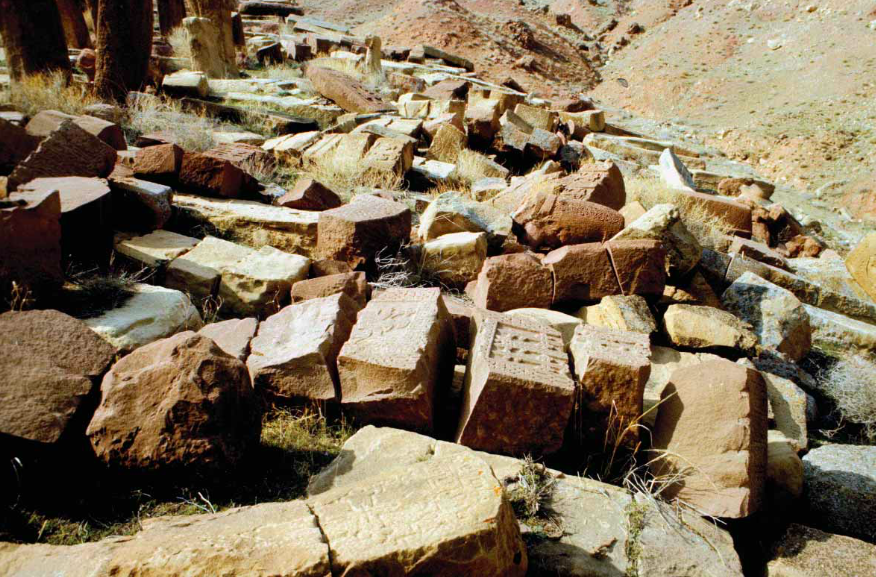

53) Reports were made in 1998 and 2003 that Azerbaijani authorities were destroyed the cemetery, the complaints fell on deaf ears. On December 15, 2005 it was completely destroyed by members of the Azerbaijani Armed Forces. A military shooting-range was built over the site. 







54) UNESCO Director, Irina Bokova (2009 -2017) has been tied to hiding this crime. The Organized Crime and Corruption Reporting Project found that in 2012-2014, shadowy companies linked to Azerbaijan paid $468,000 to Kalin Mitrev, the husband of Irina Bokova. 

55) In 2013, after a $5 million donation from Baku, UNESCO held a photo exhibition called Azerbaijan -- Land Of Tolerance, at its Paris headquarters. In 2019, the UNESCO World Heritage Committee held its annual meeting in Baku. 

56) On December 10, 2020 @RFERL published an article on the occasion of the 15th anniversary of the destruction of the Armenian Cemetery at Julfa. That same day, @IrinaBokova’s twitter profile was deactivated. rferl.org/a/armenia-azer…
57) Famous #Armenians of #Nakhichevan (1/5):
•Azaria Jughaetsi (1563-1601) Catholicos of the Holy See of Cilicia
•Hakob Jughaetsi (1598-1680) Catholicos of the Mother See of Holy Ejmiatsin
•Naghash Hovnatanyan (1661-1722) famous artist and founder of the Hovnatanyan family

•Azaria Jughaetsi (1563-1601) Catholicos of the Holy See of Cilicia
•Hakob Jughaetsi (1598-1680) Catholicos of the Mother See of Holy Ejmiatsin
•Naghash Hovnatanyan (1661-1722) famous artist and founder of the Hovnatanyan family


58) Famous #Armenians of #Nakhichevan (2/5):
•Kristapor Mikaelian (1859-1905) one of three founding members of the Dashnak (ARF)
•Stepan Sapah-Gulian (1861-1928) leader of the Hunchakian Party (SDHP)
•Manuk Abeghian (1865-1944) scholar of literature and folklore


•Kristapor Mikaelian (1859-1905) one of three founding members of the Dashnak (ARF)
•Stepan Sapah-Gulian (1861-1928) leader of the Hunchakian Party (SDHP)
•Manuk Abeghian (1865-1944) scholar of literature and folklore



59) Famous #Armenians of #Nakhichevan (3/5):
•Stepan Zorian (1867-1919) one of the three founding members of the Dashnak Party (ARF)
•Taguhi Hakobyan (1878-1947) known as “Hasmik,” the famous actress
•Ruben Orbelian (1880-1943) archaeologist who pioneered underwater archeology


•Stepan Zorian (1867-1919) one of the three founding members of the Dashnak Party (ARF)
•Taguhi Hakobyan (1878-1947) known as “Hasmik,” the famous actress
•Ruben Orbelian (1880-1943) archaeologist who pioneered underwater archeology



60) Famous #Armenians of #Nakhichevan (4/5):
•Garegin Ter-Harutyunyan (1886-1955) known as “Nzhdeh,” a famous leader
•Hakob Davtyan (1888-1938) known as “Yakov Davydov,” head of Soviet Intelligence
•Hayk Hovakimyan (1898-1967) known as “puppet master” was a Soviet spy in US


•Garegin Ter-Harutyunyan (1886-1955) known as “Nzhdeh,” a famous leader
•Hakob Davtyan (1888-1938) known as “Yakov Davydov,” head of Soviet Intelligence
•Hayk Hovakimyan (1898-1967) known as “puppet master” was a Soviet spy in US
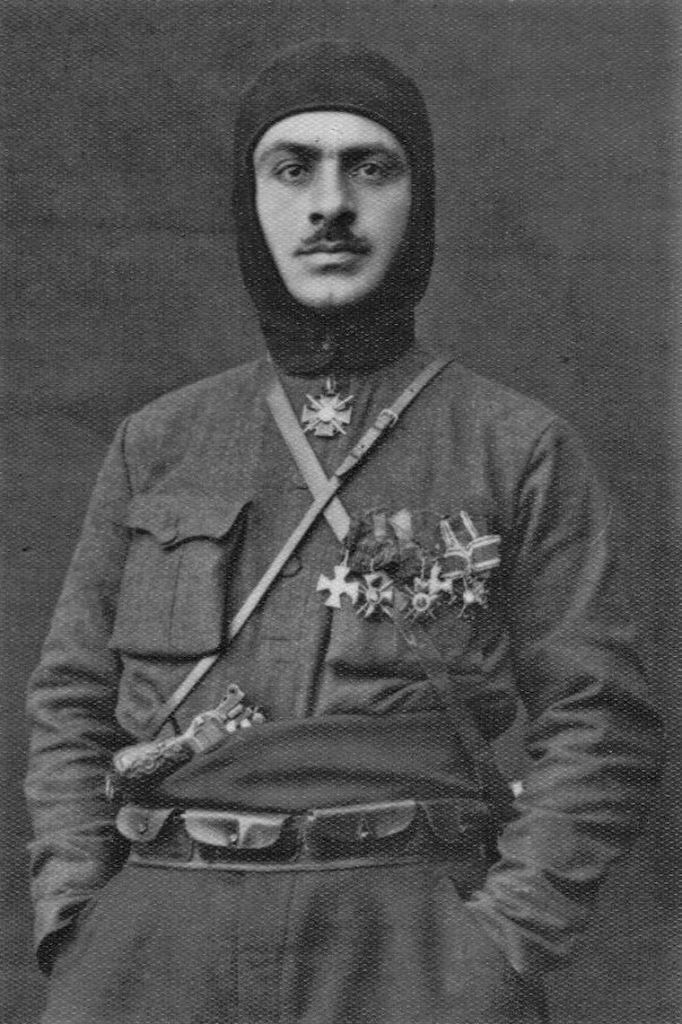


61) Famous #Armenians of #Nakhichevan (5/5):
•Vladimir Sargsyan (1935-2013) scientist and mathematician
•Argam Aivazian (born 1947) historian, journalist and archeological researcher
•Aghvan Vardanyan (born 1958) ARF member, journalist, and poet


•Vladimir Sargsyan (1935-2013) scientist and mathematician
•Argam Aivazian (born 1947) historian, journalist and archeological researcher
•Aghvan Vardanyan (born 1958) ARF member, journalist, and poet



62) The famous song, Հայեր Միացեք (Hayer Miatsek; “Unite Armenians”) by Gusan Haykazun (born 1951) has a section devoted to Nakhichevan - a lost homeland. 

63) Special thanks to Simon Maghakyan @simonforco and Research on Armenian Architecture, especially the late Samvel Karapetyan. For more information on Nakhichevan check out Argam Aivazian's work.
• • •
Missing some Tweet in this thread? You can try to
force a refresh



